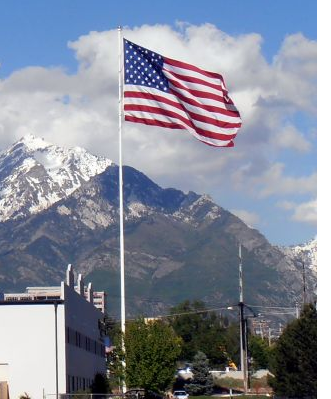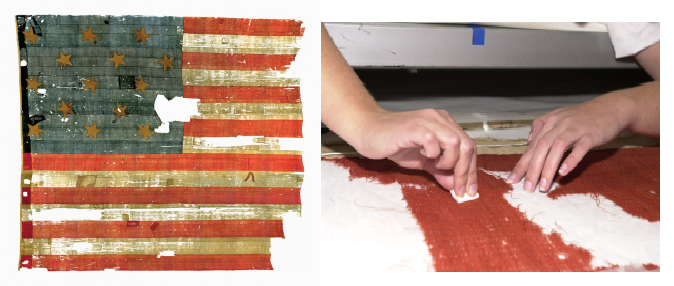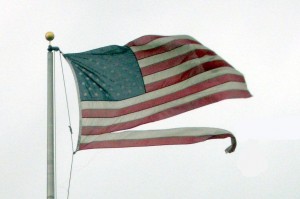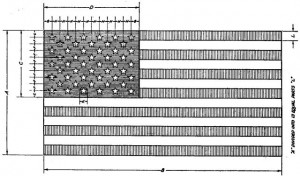Is it proper to clean and repair the U.S. flag?

A huge 30 by 60 foot U.S. Flag flies on a 120 foot pole at Colonial Flag Company. The flag was sewn on site by Colonial Flag’s expert seamstresses.
Since Colonial Flag Company makes flags and sells flags that are flown all over the world, we get questions about how to care for and display flags properly. We care deeply about how flags are displayed and flown, and we are therefore happy to answer questions about the flag etiquette as followed by individuals and the flag protocol as followed by the government, the military and by private organizations. To research answers, we check not only the U.S. Flag Code but applicable government regulations.
Recently we were asked if a flag may be cleaned and repaired. While this may seem a simple question that can be answered by and equally simple “yes” and “yes”, the complete answer is a bit complicated.
First of all it is necessary to understand that the display and use of the United States flag is not governed by a single set of instructions. The Federal Government, its agencies and the military are directed by regulations and instructions issued by the respective departments, agencies, and military services.
Display and use of the U.S. flag by civilians is described by the United States Flag Code which is found in Title 4 of the U.S. Code. However, the U.S. Flag Code is not statuary law but a set of guidelines in that it does not include any penalties. Finally, the U.S. Supreme Court has ruled as unconstitutional laws which include penalties that require or prohibit acts relating to the U.S. flag.
The U.S. Flag Code states simply that “The flag, when it is in such condition that it is no longer a fitting emblem for display, should be destroyed in a dignified way, preferably by burning” (Section 8(k), Chapter 1, Title 4, United States Code). The cleaning and repair of flags is not mentioned; it is not required nor is it prohibited.
However, earlier in the same section of the Flag Code, it states that, “No disrespect should be shown to the flag of the United States of America….” (Section 8, Chapter 1, Title 4, United States Code). It certainly can be argued that to leave a U.S. flag flying in a soiled and/or torn condition is disrespectful. We often see flags flying that are in a deplorable state of repair, some torn almost to shreds. Nevertheless, to replace flags when they first show signs of wear or becoming soiled would be very costly, especially when timely cleaning and repair allows a flag to remain “a fitting emblem for display” for a longer time.

The Star Spangled Banner is an Icon of American History. Although badly damaged over the years since it flew at Fort McHenry (when it inspired Francis Scott Key to write the lyrics of our National Anthem), the flag has been carefully cleaned and repaired and is on display at he Smithsonian in Washington, D.C.
The Army Regulation prescribing display of the U.S. flag states: “Commanders are responsible for ensuring that U.S. national flags on display are presentable at all times. Periodic inspections of flags should be made. Minor repairs such as rehemming, correcting loose stitching and mending tears or rips will be made locally provided the approved design is retained in its specified proportions.” (Paragraph 2–11, AR 840-10). This makes sense and shows proper respect for the flag.
The American Legion website further states the following:
There are no provisions of the Flag Code which prohibit the sewing or repairing the flag. We do caution that if material is removed, the flag may no longer conform to the size proportions, as specified in Executive Order 10834 (http://www.legion.org/flag/questions-answers/91467/can-flag-be-repaired-or-mended).

This flag could have been easily repaired before it tore. It shows respect to repair and clean a flag, rather than to fly it when badly torn or soiled.
Here, it is important to note that the proportions for the U.S. flag specified by Executive Order 10834 apply to flag purchased by the government. Flag manufacturers make “Government Specification” flags that follow a ration of 1.0 to 1.9 to fill these orders. However, flag manufacturers make flags of various sizes that do not follow the proportions of Executive Order 10834 and these flags are sold to civilian customers. For example, the size of the military storm flag and the internment flag is 5’ X 9’ 6”; however, the flag with a five foot hoist made for civilian use measures 5’ X 8’ in size. The usual flag sold for home display which measures 3’ X 5’ would measure about 3’ X 5’ 8 ½” if it followed government specifications. It is not required that civilians display flags following the ratio specified by Executive Order 10834. Civilian flags can be repaired and rehemmed until they become too short to be “a fitting emblem for display.”

U.S. Government Specification Flags must be made following this ratio chart. The hoist of the flag, letter A, is 1.0 and the length of the flag, letter B, is 1.9 making the correct length of a flag with a 10 foot hoist to be 19 feet. Each component of the flag has a ratio measurement comparing it to the hoist.
The largest flag flown by the military is the Garrison Flag flown on Holidays which measures 20 by 38 feet. How much the flag could be shortened by rehemming would be up to the individual military services.
Civilians often fly large flags. Due to the cost of large flags—a flag with a thirty foot hoist has a price tag of almost $2,000.00—these flags are often made using a 1.0 to 2.0 ration which is slightly longer than the 1.0 to 1.9 ration specified by Executive Order 10834. A flag measuring 30’ X 60’ can be hemmed at the fly end several times before it length would make it too short to be “a fitting emblem for display.”
To return to the original question, flags can be cleaned and repaired. Cleaning and repairing flags actually shows proper respect. As individuals, we show respect for ourselves by keeping our clothing clean and in repair. Does not the emblem of our nation deserve the same care?
